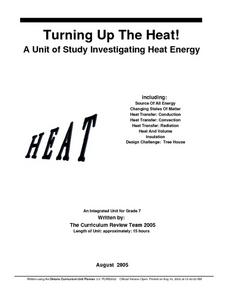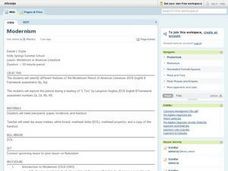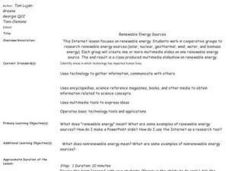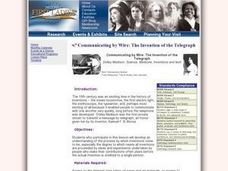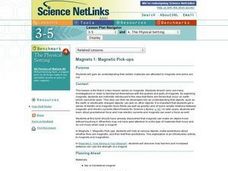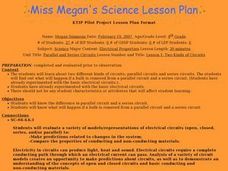Curated OER
The Science of Color and Light
Students listen to a story about colors and then conduct various experiments to determine how people see colors, identify which colors stand out best from a distance, show the results of mixed colored lighting and explain the phenomenon...
Curated OER
Let's Think About... Magnets and Gravity
Students watch an episode of the PBS show "Jay Jay the Jet Plane," and explore magnets and gravity. They conduct various experiments involving magnets and sand, bean bags, and a fishing pole with magnets.
Curated OER
U.S. History: Immigrant Scrapbooks
Students role-play as immigrants coming to America around the turn of the 19th century. They conduct Internet research and print out pictures to use in an immigrant scrapbook. Students write captions for the pictures and narratives to...
Curated OER
Immigrant Role-Playing
Students role-play as immigrants coming to America during the early 1900's. They conduct Internet research printing out pictures and reading biographies. Students use the information gathered to create scrapbooks in which the write...
Curated OER
Turning Up The Heat!
Students investigate the properties of heat. They explore methods of temperature control and measurement. Through experimentation and activities, students design a high tech tree house. They consider electrical, solar, and natural heat...
Curated OER
Modernism
High schoolers engage in a study of the literature of modernism in America. They conduct research and read different texts for clarification of the genre style. Students discuss the background influences of culture that shaped modernism.
Curated OER
Environment: Renewable Energy Sources
Young scholars, in groups, conduct Internet research on various renewable energy sources. The groups create several multimedia slides for inclusion in a class presentation. Topics covered include solar, nuclear, and geothermal power.
National First Ladies' Library
Eli Whitney: A Top Ten Inventor?
Middle schoolers conduct research and present their findings in a persuasive manner. Then they work in groups to enhance the development of cooperative work skills. Students also present their findings through persuasive skills in...
Curated OER
The Bernoulli Effect - Conceptually
Young scholars observe and/or conduct five experiments which address the Bernoulli Effect. In this conceptual activity based on the Bernoulli Effect, the students construct atomizers, and make concrete observations and inferences in...
Curated OER
Magnets
Students explore the concept of magnetism. In this magnetism lesson, students use bar magnets to conduct experiments regarding magnetism. Students also use a magnetic compasses to examine magnetic poles.
Curated OER
Products from Petroleum
Students examine products that are petroleum based. In this petroleum product lesson, students examine a display of petroleum based products. They discuss the products that are made from crude oil and conduct an experiment that...
Curated OER
Magnetic Pick-ups
Students gain an understanding that certain materials are attracted to magnets and some are not.
Curated OER
How Strong is Your Magnet?
Students measure the strength of a magnet and graph how the strength changes as the distance from the magnet increases.
Curated OER
Crash of Flight 111
Students identify the locations on a map of the airplane crashes discussed in this lesson. After watching a video, they discuss the importance of an investigation after a plane crash. They use the same information as the investigators...
Curated OER
TE Lesson: Factors Affecting Friction
Students investigate the effect of weight on normal friction or the friction due to surface roughness. They tell about the effects of contact area that occurs as a result of molecular attraction by looking at data on line graphs.
Curated OER
Conductors and Insulators
Fifth graders investigate conductors and insulators by testing their hypotheses. They use copper wire and batteries to light a bulb. They use a penny and a plastic spoon to determine which is an insulator and which is a conductor.
Curated OER
How Do Circuits Work?
In this circuits worksheet, students study a diagram showing a network of wires and switches for electrons to flow from a battery to a light bulb. Students use this diagram to complete 2 fill in the blank statements.
Curated OER
What Can I Do About Global Environmental Change?
Students complete a unit to evaluate their impact on the environment and greenhouse gas emissions. They conduct Internet research, develop a list of their electrical and energy use, calculate their share of greenhouse gases, and identify...
Curated OER
Ohm's Law
Students explore Ohm's Law. Following given instructions, students build a physical model of a conductor. They observe a relationship between the current, voltage and resistance in a conductor. After experiments, students explain the...
Curated OER
Student Exploration: Circuit Builder
In this circuit builder worksheet, students use the Circuit Builder Gizmo to answer 15 questions and complete charts about different kinds of circuits. Students will need to have access to the online Gizmo to complete the worksheet.
Curated OER
Two Kinds of Circuits
Fourth graders examine parallel and series ciruits. They experiment what happens if a bulb is removed from both a parallel and series circuit. They understand the differences between parallel and series ciruits,
Curated OER
Lights On!
Students work together to build their own simple circuits. They discover how electricity is conducted through light bulbs. They compare and contrast the differences beween a parallel and series circuit.
Curated OER
Scouting for Circuits
Fifth graders investigate electricity and how it used in a circuit to be useful energy. They also use this investigation in order to understand how energy can change forms and still be considered useful if put into the right form.
Curated OER
Circuit City
Fifth graders are introduced to the concept of circuits and how electricity works. In groups, they design their own subdivision with houses in which they have inside and outside light sources. To end the instructional activity, they...






